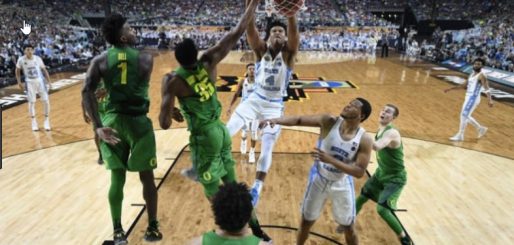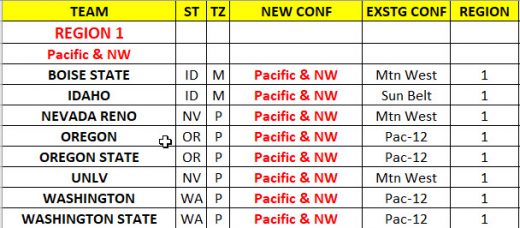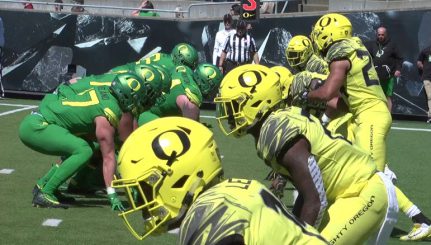Imagining an FBS “Super-Division” & Conference Play
Football Realities – Format
Didn’t legendary Coach Lou Holtz say something like “In college football you play with a different team every week?” That’s a reality of the game that Coach Holtz understood well.
Introduced in this article, the “Irresistibly Delicious” 64-Team College Football Playoff system keys in on the realities of college football better than the present FBS system.
The Realities:
- The team you begin the season with may not be the team you finish with.
- Every coach wants an initial phase to fine-tune their team as they start the season. During this tune-up phase, should a loss or even two losses deny you the opportunity for a national title run in the playoff?
- Inexperienced players will need a few games to adjust to college football. As the season progresses they can and often do improve dramatically.
- Coaches may change basic schemes as the season progresses to better respond to players’ skill sets. The team will need time to acclimate. Again, this emphasizes the value in having a tune-up period to begin the season.
- Players get injured. Replacements may need a few games to adjust and become proficient. Injured key players may return later in the season.
- Rivalry games are extremely important.
To accomplish the bigger and better playoff system, I started with a complete reorganization of the 128 (130?) teams now in college football’s FBS division, combining both Power 5 and Group of 5 teams into a single “Super-Division.” My inspirations were basic math (128/2 = 64) and the FIFA World Cup group play phase.
Why these new conference groupings? I think it’s important for the future of college football to bring the smaller schools into the big picture. Having an elite “Power 5” group of conferences that excludes all other schools creates resentment and eventual detachment from the game. For the good of the game, everyone must be included in the chance to compete for a national championship!
The NCAA’s “March Madness” basketball tournament proves even smaller schools like Butler or Gonzaga can make it to the National Championship Game and compete on the big stage! A smaller school, Coastal Carolina University, recently won the College World Series. But in college football, undefeated University of Central Florida was not allowed to play for the National Championship last season (oddly enough, UCF has almost double the enrollment of Alabama or Georgia, last year’s participants in the title game).
I organized the new 128-Team
NCAA College Football”Super-Division” like this:
- 16 Conferences.
- Eight Teams per Conference.
- Four Regions.
- Four Conferences per Region.
- 128 Teams total.
The conferences are based on geographic proximity. Why? Aren’t the most intense rivalries with your neighbors? Furthermore, closer away games encourage more traveling for fans. For example, I placed Oregon in the “Pacific & Northwest Conference” with other nearby FBS teams:
Boise State – Idaho – Nevada Las Vegas (UNLV) – Nevada Reno
Oregon – Oregon State – Washington – WSU
How many rivalry games for Oregon do you see in that conference? I see at least three: Oregon State, Washington and Boise State!
A Seven-Game Conference Season:
Each team plays every other team in their eight-team Conference to start the season. This is seven round-robin games. The concept is similar to the start of the FIFA World Cup where teams begin with round-robin “Group Play.”
A Twist – Third Year “Regional Scramble” Option:
Would fans complain their eight-team conference is too boring? If so, every third year, conferences could be “scrambled” with one-time lineups by selecting eight teams at random from the 32 teams in the Region. Keep the most important rivalry game, but mix up the remaining six conference games. The next year, conferences would once again revert to their normal lineups.
“Tune-Up” Time: Conference play would be a time of testing and experimentation, coaching up and gaining experience without being eliminated from later playoff consideration after losing one or two games. It is a time when a coach can hone his players’ skills and see what he has. It allows teams more time to develop young players who are stepping into bigger roles. Furthermore, it provides leniency in the case of injuries. This increases the opportunity for Cinderella teams to jell and catch fire later in the season.
Group of 5 and Power 5 Teams in the Same Conference? From a practical standpoint, the larger Power 5 schools play the smaller schools now anyway. There are always upsets. Smaller schools can play with the bigger ones. Troy beat LSU in 2017. Northern Illinois beat Nebraska. Appalachian State beat Michigan.
Rivalries: as stated above, the biggest rivalries are usually based on geographic proximity. Think Alabama v. Auburn, UCLA v. USC, Michigan v. Ohio State, Florida State v Miami, and of course, Oregon v. Washington. This conference grouping method will enhance most existing rivalries and develop new ones within each region.
Advancing to the National Playoff:
The top four teams in each of the 16 eight-team conferences move into the National Playoff. Hence, 64 teams total. Final ranking within the conference is based strictly on hard data and statistics like points scored, points against, point differentials, etc. There are no “committees” deciding who advances to the National Playoff. The players and coaches decide on the field who advances.
View the Surprising New Conference Groupings here – LINK
NEXT – Article Four: A UNIQUE 64-Team Playoff: Exciting & Unpredictable!
(This is Article Three in a five-part series on creating a new FBS Super-Division and 64-Team National Playoff – “The Irresistibly Delicious”. Each article may be read independently. Links to Articles One & Two are below.)
LINKS
Article One: Fantasizing a College Football “Super-Division” & “Irresistibly Delicious” 64-Team Playoff System!
Article Two: Organizing a New College Football Playoff System for MAXIMUM IMPACT!
Walter Gray
Papillion, Nebraska
Related Articles:
Oregon Enters Playoffs Better Off Than Last Year
Will The Coaching Carousel Kill Oregon's CFP Chances?
The Playoff Formula Hasn't Changed
Oregon Aims to Bury Dawgs, Punch Playoff Ticket in Rivalry Clash
Huskies Are the New Beavers, Stay In Your Lane Kiffin, and the Civil Apple Cup War
Oregon Football: The X-Factor Vs. Washington
Walter Gray was born in Washington DC; but, thankfully, grew up on the Outer Banks of North Carolina. Sun, sand, the ocean and hurricanes. He’s tri-coastal in his college degrees – College of the Albemarle NC (AA), UofO (BA 1975), Rice University in Houston (Master of Architecture) – and has lived all over the USA.
While in graduate school at Rice he started an architectural bookselling and publishing company, which he ran for years, with customers around the world. Then, he became involved in consulting with smaller IT software companies to help them grow. Now at 70 he grows and designs his garden. He and his wife Debra live in Papillion NE. His daughter Kelsey is a Lewis & Clark College graduate and lives in Portland. He loves to conceptualize new approaches to an issue or problem.
Since the 1990’s, he’s been increasingly hypnotized by the Oregon Ducks and especially loved watching Chip Kelly’s teams with their explosive unpredictability. He’s neither a “football analyst” nor a “football writer”. But, because of his architectural design education, he is someone who enjoys developing ideas that he finds intriguing.






